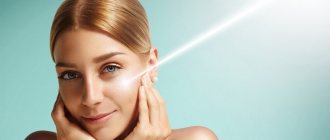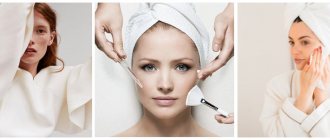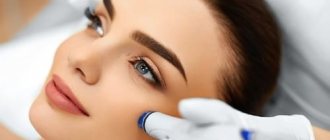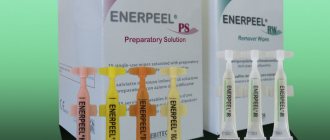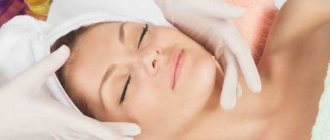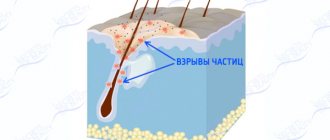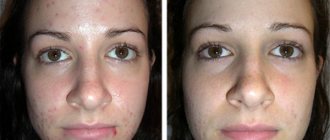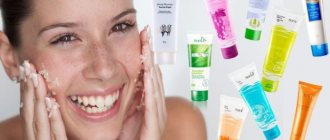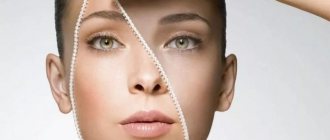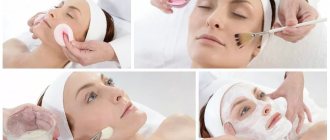Gayane Hovhannisyan
Cosmetologist/dermatovenereologist with more than 7 years of experience
Ask a Question
Retinoic (yellow) peeling is a popular, safe and effective cosmetic procedure. It has a complex effect on the skin, freeing it from old surface cells and launching natural processes of regeneration and rejuvenation in the dermis.
The composition of the drugs used includes a vitamin A derivative, which helps to increase the protective properties of the skin and prevent cancer.
Types of peeling with vitamin A derivatives
In practice, two types of yellow peeling are used:
- Retinol . The active substance in it is natural vitamin A (retinol). It is used alone or in combination with ascorbic and other acids. The effect of such peeling will be “soft” and gentle on the skin; adverse reactions are practically eliminated. Due to its naturalness, the procedure can be repeated monthly, without prior preparation.
- Retinoic (classic) . The active ingredient in it is isotrethionine (13-cis-retinoic acid, a synthetic analogue of vitamin A) in a concentration of 5 to 10%. Various manufacturers supplement it with auxiliary active substances. Retinoic peeling has a more aggressive effect on the skin and a pronounced effect. It is used no more than 2 times a year, with a minimum break between courses of two weeks.
There are two varieties of the classical method:
- One-day . The client leaves the cosmetologist with a mask on his face. The latter is washed off independently with water and products with a neutral pH after some time (most often after 12 hours).
- Two-day . In this case, the medicinal composition is applied several times over two days. The specialist decides which option to use after a preliminary consultation and examination of the skin type and condition.
Protocol for pyruvic peeling
Stage I. Pre-peeling preparation
For 14–21 days, the patient should apply Prepeel Active cream to the facial skin previously cleansed with Cleanser Mousse at night. For problem skin, you need to use Anti Acne Complex gel. Apply MediScreen MCP sunscreen in the morning.
Stage II. Chemical peeling
1 step.
Cleansing. Apply Cleanser Mousse to facial skin, spread with light massage movements and leave for 15–20 seconds. Rinse with water. Dry the skin.
Step 2.
Using a cotton pad, carefully, with quick movements, apply the peeling composition to the skin in the following sequence: starting from the forehead, then the chin, cheeks, perioral area, wings of the nose and eyelids. The specialist performing the procedure requires constant monitoring of the patient's skin condition. Exposure time is individual. If signs of erythema appear, the drug should be neutralized
Step 3.
Without removing the peeling composition from the skin, apply Neutralizator in reverse order, starting with the areas of greatest sensitivity (eyelids) and ending with areas of least sensitivity (forehead). Rinse off with plenty of water. Dry the skin.
Step 4
Apply Vegefarma or Thriphalan MCP cream to the skin.
For the first 1-2 days after the procedure, the patient should use Vegefarma moisturizing cream (for normal to dry skin) or Vegelip (for oily skin), and Mediscreen sunscreen in the morning.
Expected reactions after pyruvic peeling:
- Erythema, which can persist from several hours to one day; — Peeling of the skin for 2–4 days after the procedure.
Peeling programs
For seborrhea and acne, peeling is carried out once every 7–14 days. For hyperpigmentation, peeling is carried out once every 10–14 days in combination with depigmentation therapy. For age-related changes, the procedure is performed once every 10–14 days. An intensive course includes up to 10 procedures, carried out 1–2 times a year. Maintenance course – 1 procedure every 1–1.5 months.
Composition of retinoic peeling and its properties
Classic peeling, thanks to retinoic acid, has a yellow or orange color. It may include:
- vitamins - to enrich the skin with useful substances;
- plant extracts (aloe, chamomile) - for anti-stress effects;
- phytic acid - for anti-inflammatory and renewing effect;
- kojic acid - for the removal of dead cells;
- azelaic acid - to remove pigmentation and suppress the functioning of the sebaceous glands;
- allantoin - for a tightening, regenerating, rejuvenating effect.
The selection of specific substances is made by a cosmetologist, depending on the individual characteristics of the client.
Carrying out the procedure
The procedure for exfoliation depends on the chosen drug. In any case, the doctor first conducts an examination and then cleanses the skin. The acid solution can be applied in one or several stages; the exposure time is selected individually depending on the active substance and skin type.
Important: you must inform your doctor about your feelings during the procedure. A slight tingling sensation may be a normal reaction, but if the face begins to “burn”, itching or pain appears, the session should be stopped immediately.
Pros and cons of the procedure
Yellow peeling has the following advantages:
- quick long-term comprehensive positive result;
- universal use for any skin type (even especially sensitive);
- superficial and gentle nature of the effect, minimal risk of undesirable consequences on the dermis;
- relative safety and painlessness of implementation, in comparison with other chemical peels;
- short recovery period - 1-2 days, less often up to 1 week.
Any peeling has its downsides, and retinoic peeling is no exception. Its disadvantages are:
- the possibility of an allergic reaction to the drug;
- the likelihood of undesirable consequences - too pronounced large-plate peeling, hyperemia, itching, swelling, tightness, etc.;
- the need to get home with a mask on your face and wash it off yourself at home - with one-day exposure;
- the relative duration of the procedure is for a two-day exposure.
The peeling has a rich yellow color, which, after rinsing off, can remain on the skin for some time in the form of a characteristic shade.
Indications for yellow peeling
Peeling with vitamin A (retinoic) is recommended if you have:
- signs of aging on the skin, withering, ptosis of soft tissues associated with a decrease in the production of collagen and elastic fibers;
- noticeable defects in the skin texture (creases, scars, acne marks, etc.);
- pigmentation, freckles, signs of photoaging;
- increased oily or dry skin;
- hyperkeratosis, comedones (blackheads), acne and some other dermatological problems.
It is also indicated for the prevention of cancer processes on the skin, increasing its protection and local immunity.
Pyruvic peeling
Pyruvic acid peeling is a procedure that can help eliminate the first signs of aging. It is also called green. Like any other type of peeling, this one is responsible for deep cleansing.
The active substance used in pyruvic peeling is concentrated pyruic acid. After the procedure, the skin becomes smooth and velvety. By the way, this type of peeling is not only ideal for moisturizing the skin, but also for lightening.
At our IdealMed medical center, qualified specialists will perform pyruvic peeling safely and without pain. In their work they use highly effective techniques, so effective results are guaranteed.
Benefits of pyruvic peeling:
the procedure does not cause tightness, dryness or flaking of the skin;
gently and gently exfoliates the skin, stimulates cellular renewal;
gently and gently exfoliates the skin, stimulates cellular renewal;
the components of the active substance penetrate into the middle layer of the epidermis, so the effective result will last much longer than with other peels;
no restrictions on skin types, suitable for everyone;
no side effects, allergic reactions, virtually no pain (there may be a slight burning sensation, but this is normal in this procedure);
After the session, the skin accepts various cosmetic products well. Therefore, peeling can be safely completed with masks, serums and concentrates.
Types of pyruvic peeling
The procedure is divided into 2 types and differs from each other in different effects on the skin.
Median. Suitable for those with acne and hyperpigmentation. Peeling helps get rid of these spots and begin the fight against the first signs of aging.
Superficial-medium. Designed for those with dark or sensitive skin. In these cases, pyruvic peeling is necessary to prevent photoaging and combat acne.
Indications:
- post-acne, comedones, blackheads;
- active pigmentation;
- disruption of the sebaceous glands;
- increased oiliness or flaking of the skin;
- loss of skin turgor and elasticity;
- enlarged pores.
Contraindications:
- pregnancy and lactation;
- elevated temperature;
- herpes in the acute stage;
- skin inflammatory diseases;
- individual intolerance to peeling components.
Effects achieved with pyruvic peeling
- Antibacterial (achieved by shifting the acid-base balance of the epidermis).
- Anti-inflammatory (suppresses manifestations of the inflammatory reaction, such as swelling, redness, vasodilatation).
- Brightening and exfoliating (due to epidermis rejection).
- Regulation of the sebaceous glands (as it is a fat-soluble substance and easily penetrates the sebaceous glands).
- Anti-aging (during medium peeling, it stimulates collagen formation, which increases skin elasticity and firmness).
IMPORTANT! The number of sessions, acid concentration, depth of exposure and duration of the procedure are determined strictly individually and depend on the condition of your skin and the combination of problem areas. The optimal result appears after 3-4 procedures with an interval of 2 weeks.
Preparation for the procedure and recovery period
Before the session, we cleanse the skin of cosmetics and degrease. Before peeling, we apply anesthetics, so you will not feel the impact of the needle.
After the recovery period (5-10 days), the skin looks tightened, fresh, and moisturized. Pigmentation brightens, expression lines disappear, the activity of the sebaceous glands decreases, and acne rarely appears.
After the procedure, you should limit sports activities, visits to baths and saunas. Do not use decorative cosmetics throughout the recovery period.
You can sign up for a pyruvic peeling procedure in Minsk at a medical clinic by calling +375 (17) 395-55-77, +375 (29) 144-22-22, +375 (29) 88-88-195.
Contraindications to retinoic peeling
Restrictions to retinoic peeling are:
- any violation of the integrity of the skin in the treatment area (cuts, burns, etc.);
- dermatological diseases (warts, seborrhea, eczema, etc.);
- acne in the active stage;
- individual intolerance to the components used;
- immunodeficiency;
- high photosensitivity of the skin;
- active infections, including herpes;
- serious diseases of the body, especially in the stage of decompensation (hepatitis, diabetes, etc.);
- recent use of retinoids (less than six months) and treatment with radiation, chemotherapy and antibacterial therapy;
- pregnancy, lactation - the last peeling with isotretionine (yellow) should be carried out at least six months before conception.
Many experts do not recommend carrying out the procedure before 35 years of age and during the summer season.
Preparation for the procedure
Before coming for a classic peeling, you should prepare, which will take from 2 to 4 weeks. It includes:
- consultation with a cosmetologist, selection of a suitable drug;
- daily use of special cosmetics with fruit acids to make epidermal cells more pliable and soften the skin;
- refusal of any type of insolation, thermal procedures (sauna, steam bath) and some aesthetic manipulations;
- carrying out symptomatic measures (preliminary biorevitalization or mesotherapy for dry skin, antiviral therapy for herpes, etc.).
Retinoic peeling technique
Experts note that it is advisable to carry out any peeling, including yellow peeling, in a salon. Manipulation done independently at home can lead to undesirable consequences and cause an unplanned effect.
The cosmetologist performs the following steps:
- cleansing the skin of impurities;
- applying a thin layer of a mixture of active ingredients (sometimes a slight tingling or pinching of the skin may be felt);
- sending the client home with a mask on his face, which must be washed off after a certain period of time (one-day session) or repeated application of the composition over two days.
After the classic peeling with retinoic acid has been carried out, the recovery period begins. The patient may experience peeling at the treatment sites, minor itching, swelling, soreness and tightness of the skin. These phenomena go away on their own after a few days. Otherwise, you should immediately consult a doctor.
Skin care after the procedure
The rules of the rehabilitation period are as follows:
- if the composition is removed at home, use sponges or cotton pads moistened with water and products with a neutral pH level;
- daily care is carried out for the treated area, using healing agents and creams (D-Panthenol, Bepanten);
- for several days, while peeling occurs, you should not forcibly tear off the scales and layers of the epidermis or scratch the skin;
- before going outside, the skin is covered with sunscreen lotions with SPF 30 or more;
- makeup and aggressive cosmetics (scrubs, exfoliating wipes, etc.) are temporarily excluded.
For several weeks it is prohibited to visit the solarium, bathhouse, sauna, or gym. You cannot perform other cosmetic procedures, consume spicy foods and alcoholic drinks, or use hormonal drugs. It is advisable to reduce or completely eliminate nicotine consumption.
If peeling with retinoic acid does not cause significant peeling of the skin, you should not panic. This can happen for a number of reasons:
- individual characteristics of the epidermis (the layer of dead cells is so dense that it could not be prepared for the procedure and provided the desired effect, or the skin has a strong resistance to damage);
- different effects of the drugs (some formulations cause exfoliation on 2-3 days, others – after 1-2 weeks);
- all keratinized cells came off immediately when the mask was washed off (this happens in people with delicate thin skin);
- the cosmetologist performed a gentle procedure (this is possible if chemical peeling is performed for the first time in life, and the specialist consciously makes it softer).
Possible complications after the procedure
Properly performed peeling, after the yellow mask is washed off, does not cause complications. Sometimes you may feel the urge to scratch your face and pick off dead skin. In the first few days, local reactions may be observed in the form of redness, swelling and tightness of the skin, but this is considered normal.
Negative consequences are possible under the following conditions:
- the technique of the peeling procedure was violated;
- the rules of preparation or rehabilitation period were not followed;
- low-quality drugs were used;
- individual intolerance or allergy suddenly appeared;
- there was an overdose of vitamin A, which can accumulate in the body.
The latter option is possible due to the simultaneous use of retinol topically and orally, as well as with excessive sun exposure. In case of overdose, the following may occur:
- symptoms of intoxication:
- pronounced local manifestations on the skin (severe itching, dermatitis, relapse of acne, hyperpigmentation);
- dry lips and mucous membranes of the eyes;
- decrease in the protective functions of the skin.
To avoid complications, it is necessary to carry out the manipulation by a qualified specialist and strictly follow his recommendations.
Operating principle
The upper - horny - layer of the skin consists of dead cells. It performs a protective function, protecting the body from the penetration of harmful substances and mechanical influences. This layer is constantly renewed - old cells are exfoliated, and new ones, rising from the deeper layers of the epidermis, take their place. With age, this process slows down, and the thickness of the stratum corneum increases. As a result, the skin looks uneven and dull. Peels will help restore its smoothness and radiance.
The procedure involves partial removal of the upper layer of the epidermis. Acid-based preparations do an excellent job of this task. They destroy the connections between the cells of the stratum corneum and promote skin renewal. In this way, you can restore its youthful appearance and get rid of defects (Evidence on the use of chemical peeling for skin diseases and aesthetic resurfacing).
Unlike medium and deep chemical peels, superficial varieties only affect the stratum corneum. This is the most gentle type of exfoliation, which has the softest, most delicate effect on the skin.
Expected effect after yellow peeling
After the layer of old epithelium comes off the skin, you can evaluate the result:
- increased production of hyaluronic acid, collagen and elastin fibers, supply of nutrients to cells and removal of toxins;
- general improvement and rejuvenation of the skin;
- elimination or reduction of pronounced wrinkles, creases, stretch marks, age spots, freckles and other skin defects;
- reduction of acne and acne scars, narrowing of enlarged pores;
- minimizing the risk of developing benign and malignant neoplasms on treated skin;
- strengthening the barrier function of the skin.
If dermatological problems are severe, several sessions with a cosmetologist may be needed to achieve the desired result. You can carry out the peeling procedure at the Novoklinik aesthetic medicine centers. You can sign up for a consultation by phone or on our website.
Cosmetic procedures are contraindicated during pregnancy and lactation.
Superficial peeling
Superficial peeling is a simple procedure for exfoliating the upper stratum corneum of the skin using various types of acids used in cosmetology. Its main goal is to cleanse the skin and cope with some defects in the form of fine wrinkles, age spots, acne (acne). This peeling is considered the most gentle and safe due to its minimal impact on the skin. Can be used as a separate procedure, as well as as preparation for medium and deep types of peeling and laser resurfacing.
To carry out surface peeling, the following acids are used (lactic, glycolic, mandelic, pyruvic, retinoic). Glycolic acid is considered one of the most common in cosmetology practice. It is present in varying proportions in sour milk, some fruits and wine.
Types of peelings in order of increasing acid strength
Peeling with lactic acid
– is the weakest peeling, used in the presence of fine wrinkles, dull complexion, well suited for very sensitive skin.
Almond peeling
– carried out using phenoxyglycolic acid obtained from bitter almond extract. Also refers to rather weak peelings, used for acne, rosacea and moderate signs of photo- and bioaging. Like milk peeling, it is ideal for sensitive skin.
Glycolic peeling
intended primarily for those who have problematic skin with enlarged pores, prone to inflammation and acne. Due to the fact that the glycolic acid molecule is very small, it is able to penetrate the dermis and stimulate cellular regeneration, which leads to rejuvenation and tightening of the skin. Hyperpigmentation, as well as seborrhea, respond well to the effects of this acid.
Pyruvic peeling
(“Green peeling”) – due to the pronounced anti-inflammatory and antimicrobial effect of pyruvic acid, it is used primarily in the presence of acne. Compared to other superficial peels, it causes less dry skin.
Salicylic peeling (15%)
– salicylic acid has a pronounced comedolytic effect, so this peeling is most suitable for patients with acne and folliculitis. It is also necessary to carry out before retinoic peeling to enhance penetration.
Retinoic peeling
created on the basis of retinoids, substances that actively stimulate the skin. They are synthetic analogues of vitamin A. Under their action, collagen and elastin are synthesized, which leads to a noticeable lifting effect. Retinoic peeling is used primarily to correct hyperpigmentation, as well as signs of photo- and bioaging.
Carrying out the procedure
First of all, the doctor must determine your skin type and, based on this, prescribe a particular concentration of acid and the time of its exposure. With superficial peeling, the top layer approximately 0.06 cm thick is peeled off. The duration of a superficial peeling session ranges from 10 to 60 minutes, it all depends on individual indicators. Minor tingling sensations during the procedure are normal.
The course consists of 5-10 visits, the frequency of which will be recommended to you by a cosmetologist. After the procedure, fine wrinkles are smoothed out and the skin takes on a healthy appearance.
Contraindications:
- Herpes on the skin in the acute stage;
- Pregnancy and lactation;
- Less than a week after hair removal or mesotherapy.
